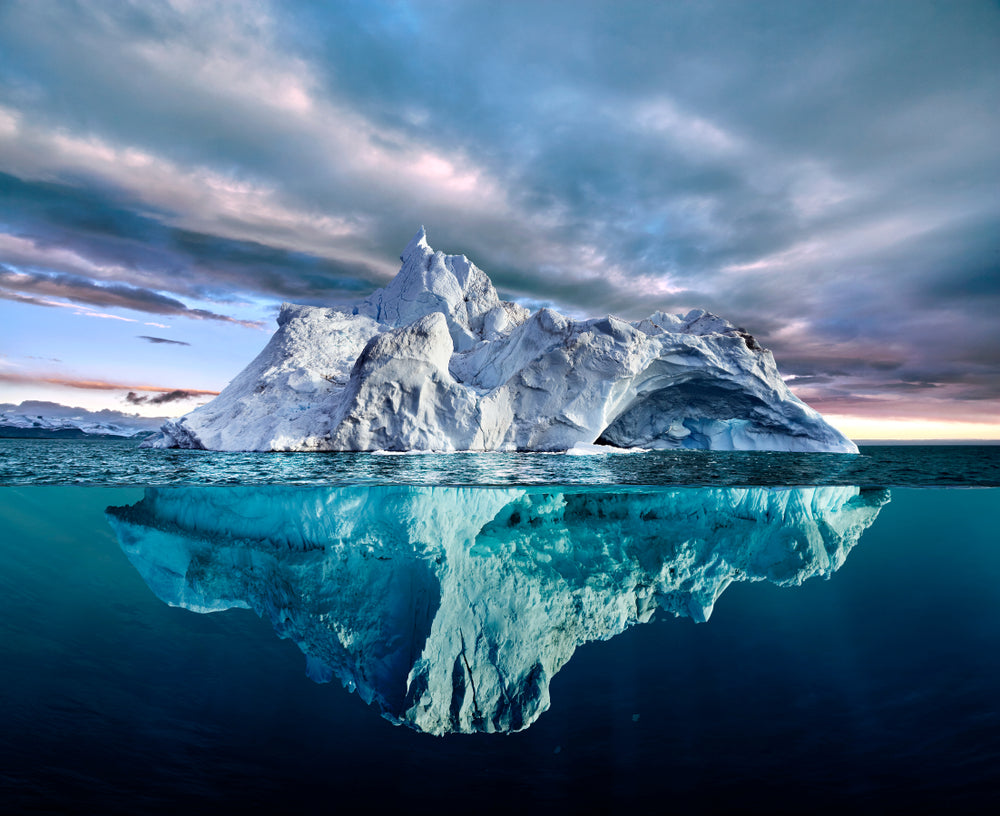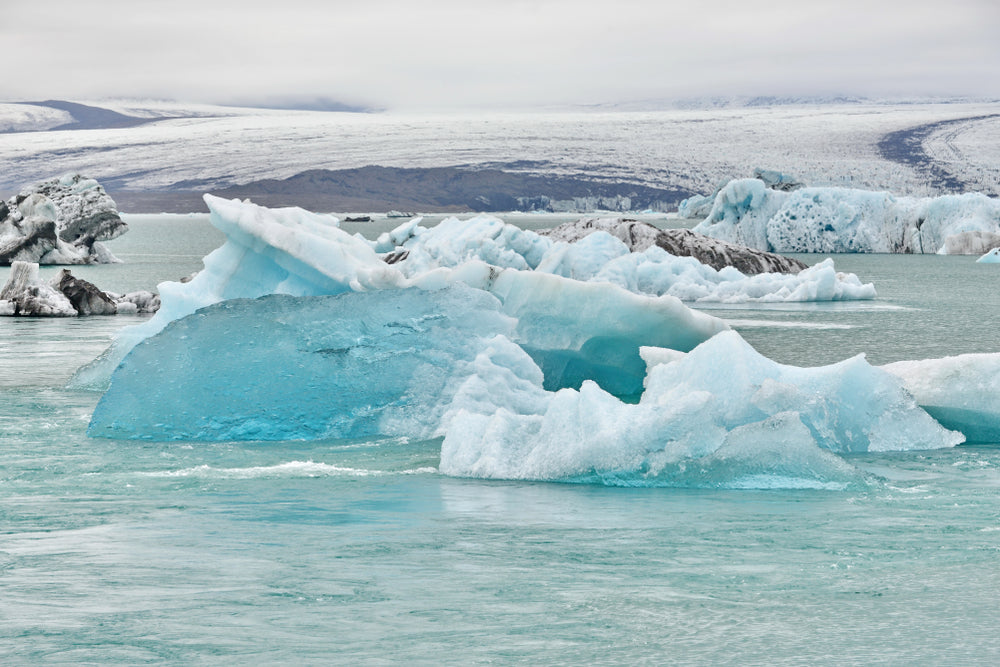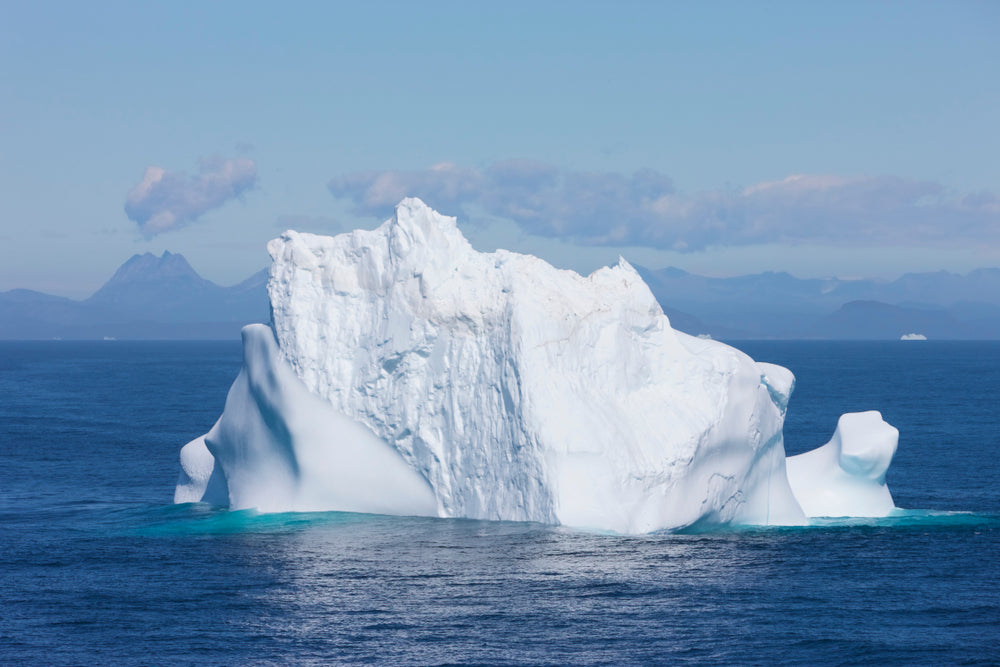Climate change discussions focus a lot of attention on what’s happening in the coldest areas of Earth. One important topic has been the relationship between a melting iceberg and sea level.
Icebergs link closely to glaciers, ice shelves, and ice sheets. Take a look at these ice formations to learn how they interact with each other and the ocean’s water.
What exactly is an iceberg?
An iceberg is a chunk of ice that has broken off of a glacier or off of shelf ice. It floats in open water.
To be classified as an iceberg, the ice must rise more than 16 feet above the level of seawater and overall be at least 98 feet thick. (Most of an iceberg is under the water where you can’t see it.) To be classified as an iceberg, its mass has to be at least 500 square meters.
One huge iceberg named B-15, broke away from Antarctica’s Ross Ice Shelf in the year 2000. It was larger than the entire island of Jamaica.
At that time, it was the biggest single chunk of ice ever to split off from the shelf, measuring 160 nautical miles long and 20 nautical miles wide.
NASA scientists reported that after drifting for nearly 20 years and traveling over 10,000 kilometers, it ended up near the tail of South America. What was left of the iceberg was seen on satellite photos headed for warm tropical waters.
But more recently, in 2017, a break at the Larsen C Ice Shelf in Antarctica unleashed a massive iceberg more than 2,200 square miles in area, weighing a trillion tons.
What is a glacier?
A glacier is a huge body of dense ice that forms on land, and moves slowly but constantly due to its vast weight. Its speed depend on the slope of the land and the glacier’s volume.
Glaciers form when snow and ice don't completely melt away in warmer months. Each winter new snow falls on top of the old, and the thick layers gradually compress into glacial ice.
A glacier looks like a solid block despite the fact that it’s moving. By the time it reaches water and enters the sea, a glacier iceberg may look dirty because of rock and sediment it picked up along the way.
What are ice sheets and ice shelves?
An ice sheet is huge - a mass of glacial ice over 50,000 square kilometers. Ice sheets are sometimes called continental glaciers.
Today, there are only two ice sheets in the world: the Antarctic Ice Sheet and the Greenland Ice Sheet. During the last glacial period, much of the Earth was covered by ice sheets.
An ice shelf is an expanded type of ice sheet that originates on land but continues out to sea beyond a depth at which it rests on the sea bottom.
Ice shelves are considered part of the ocean, constantly moving from a solid to a liquid state. Ice shelves do not directly make the sea-level rise, but they support (hold back) the glacial ice that’s on land. When ice shelves fall away, their stabilizing effect is lost, which frees glaciers to speed up their journey from land to ocean.
Where are icebergs found?

Worldatlas.com explains that icebergs require specific conditions to form. That’s why they’re found only in the regions of the world such as Antarctica with its very cold temperatures.
Besides the Antarctic and its sea ice, Greenland is an area known for icebergs due to its unique climate. Almost 80% of that region's territory is covered by ice, making it the perfect location for icebergs to form.
Why are melting ice and changing sea level of concern to researchers?
If sea levels rise in the future, this poses a threat to coastland communities. Melting ice could be caused by natural causes, manmade effects, or a combination of both.
As ice shelves melt away, glaciers encounter less resistance and move more quickly. More icebergs break off as a result (this breaking off is called “calving”). This could result in the rise of sea levels as icebergs melt and add to the volume of ocean water.
Geologist Trevor Nace shares his view that regardless of your thoughts on climate change (i.e. who or what is to blame for it), the world's ice is measurably melting and at a rapid pace.
“Humans would have to adapt to a very different world as ice melts and oceans rise. Most of the Atlantic coast, Florida, and the Gulf Coast will be underwater. In addition, large scale climate variations will alter seasonal rainfall, creating infertile land where it once was fertile.
One upside is that it will take thousands of years for all the ice on the planet to fully melt. Hence giving humans generations to adapt to a wildly different planet.”
Changes in sea level are not new. The National Academies Press provides some helpful background:
Sea level has varied dramatically over Earth’s history. For the past two to three million years, ice age cycles have led to regular fluctuations in sea level of several hundred feet. During an ice age, significant amounts of water are stored in continent-sized glaciers called ice sheets up to several miles thick.
Much of this ice melts during warm interglacial periods, and the resulting water raises global sea level substantially when it enters the oceans. During the most recent ice age, which peaked about 26,000 years ago, the global average sea level was approximately 400 feet lower than it is today.
What parts of the world experience ice melting?
Discussions about melting ice are focused on the Antarctic and Greenland areas. If warming increases over the long haul, other areas where ice is found around the world could be affected too.
What do researchers say about the rising sea level?

There are differing opinions on the level of threat that melting ice holds. Part of the challenge is that despite much research, experts run into limitations of what can be predicted.
Globally, the average sea level is currently rising at a rate of about 3 millimeters per year. It’s believed this is primarily caused by ocean warming and the melting of ice sheets on Greenland and Antarctica.
Certain parts of the world face a greater risk of flooding. The science behind how melting ice affects sea level is complicated.
Gravity, changes in ocean currents, air and water temperatures, saline levels, melting of mountain glaciers, changes in land-water storage, and weather patterns all play a role, too.
Four decades of research on Antarctica concludes that a loss of mass has occurred, more on the west coast of Antarctica than the east coast, and no balancing accumulation of snowfall. The researchers of this study attribute much of the loss to warm, salty, circumpolar deep water which has intruded on the ice shelves.
But there are other meteorological studies like one that Forbes.com offered, sharing new data that ice mass is actually accumulating on the Antarctic continent as well as in the ocean surrounding Antarctica.
The data contradicts global warming reports that expanding Antarctic sea ice is coming at the expense of less Antarctic continental ice. One NASA study finds Antarctica once supported vegetation similar to present-day Iceland, so there may have been a warmer climate there at one time.
Another example of conflicting opinions is the case of the Larsen C iceberg mentioned earlier. Some researchers believe this is a geographical event and not a climate event since the rift in the ice had been present for decades.
A professor of glaciology who studied Larsen C for years shares that this “may simply be a rare but natural occurrence. Because, despite the media and public fascination, the Larsen C rift and iceberg “calving” is not a warning of imminent sea-level rise, and any link to climate change is far from straightforward.”
He says there will be no direct effect on sea level because the iceberg is already afloat and displaces its own weight in seawater.
Contrast his report with National Geographic’s headline: The Larsen C Ice Shelf Collapse Is Just the Beginning—Antarctica Is Melting.
The massive iceberg that broke off the Larsen C Ice Shelf may be a harbinger of a continent-wide collapse that would swamp coastal cities around the world.
Others are convinced climate warming caused the separation of this iceberg. Scientists involved closely in its study say they have no direct evidence to support this. They are concerned, however, about how the break-off could impact the rest of the ice shelf.
A New York Times article reports that there’s no scientific consensus over whether global warming is to blame for the Larsen C breaking free. Clear as mud, right?
Are volcanoes a part of the puzzle?
Further confounding the assessment of climate change, scientists discovered recently there are 91 volcanoes below the Antarctic ice sheet - in addition to the 47 they already knew were there!
Volcanic eruptions may not reach to the surface, but could melt the ice from beneath and destabilize it. One expert says volcanic activity could increase as the Antarctic ice sheet decreases.
“If you have thinning ice cover over a volcanic region there’s every reason to suggest it will increase the volcanism,” he said.
As pressure exerted on the mantle by the glacier decreases and allows more heat to escape, this could cause a feedback loop in which the melt rate increases.
Researchers behind this study said understanding the rate of sea-level rise due to a melting Antarctica will be crucial in the coming years, and monitoring the region’s volcanoes will be a key part in this process.
What are some solutions that experts suggest to alleviate the rising sea level problem?

Many solutions focus on reducing human effects on the environment, including
- Reducing the carbon footprint and energy use.
- Protecting wetlands that act as natural buffers for coastal areas.
- Using permeable surfaces rather than hard surfaces that prevent water absorption.
- Plant more plants and save trees.
The potential cost of providing new infrastructure to protect against rising seas is massive. Seawalls, storm surge barriers, and floodgates will likely run into the billions. The question of who will pay for these improvements is daunting.
The organization Sea Level Riseproposes these 4 specific actions among others:
- Proactive Protection - protect coastal communities before major flooding damage happens, and not wait for a disaster to strike. Every $1 spent on disaster mitigation saves $6 in disaster relief.
- Building Back Stronger - After flooding and natural disasters, communities need to rebuild stronger and more resilient to avoid the same problem again.
- Future-Proofing Communities - more forward-thinking building codes, evaluating coastal development, and planning infrastructure to withstand higher seas in the future.
- Conservative Planning - Taking a hard look at the risks of sea-level rise and flooding to help communities make realistic financial plans.
Are there any outside-the-box ideas for fighting rising sea levels?
One creative team of designers "propose building iceberg-making submarines that would ply polar waters and pop out icebergs to replace melting floes," reports NBC News.
The designers of the submersible iceberg factory explained in an animated video that sea-level rise due to melting ice shouldn’t only be responded to with defensive solutions. The group leader came up with their design to complement efforts for curbing emissions.
Their proposed submarine dips beneath the ocean surface to allow seawater to fill a large well. When the vessel surfaces, a desalination system removes the salt from the water and a "giant freezing machine" and low surrounding temperatures freeze the water to create hexagonal 25-meter-wide bergs.
These bergs float away when the vessel resubmerges to start the process over again. A fleet of ice-making subs operating continuously could create enough ice to make a larger ice sheet, according to the designers.
Their idea took second place in a recent design competition held by the Association of Siamese Architects. Experts praised the designers' vision but were unsure of the project's feasibility.
